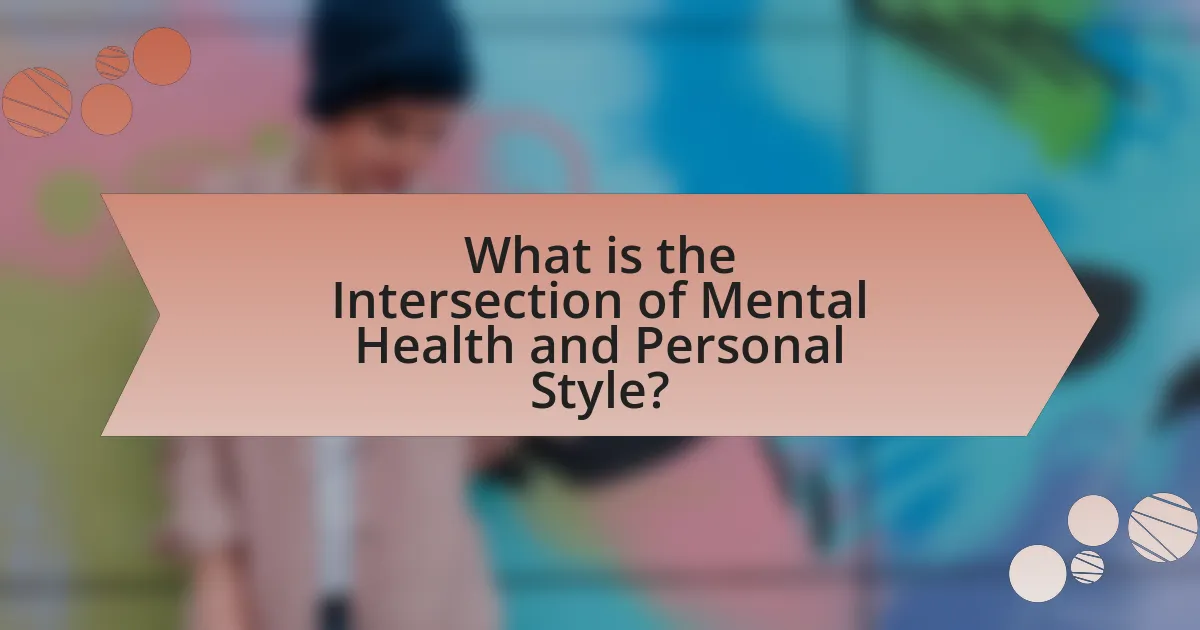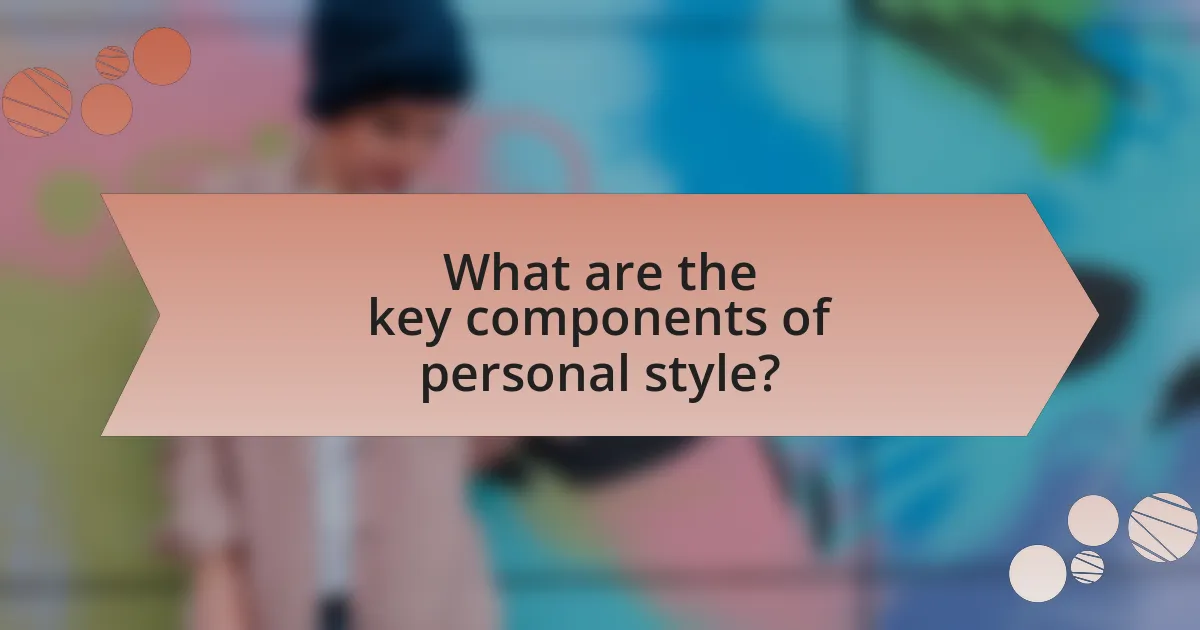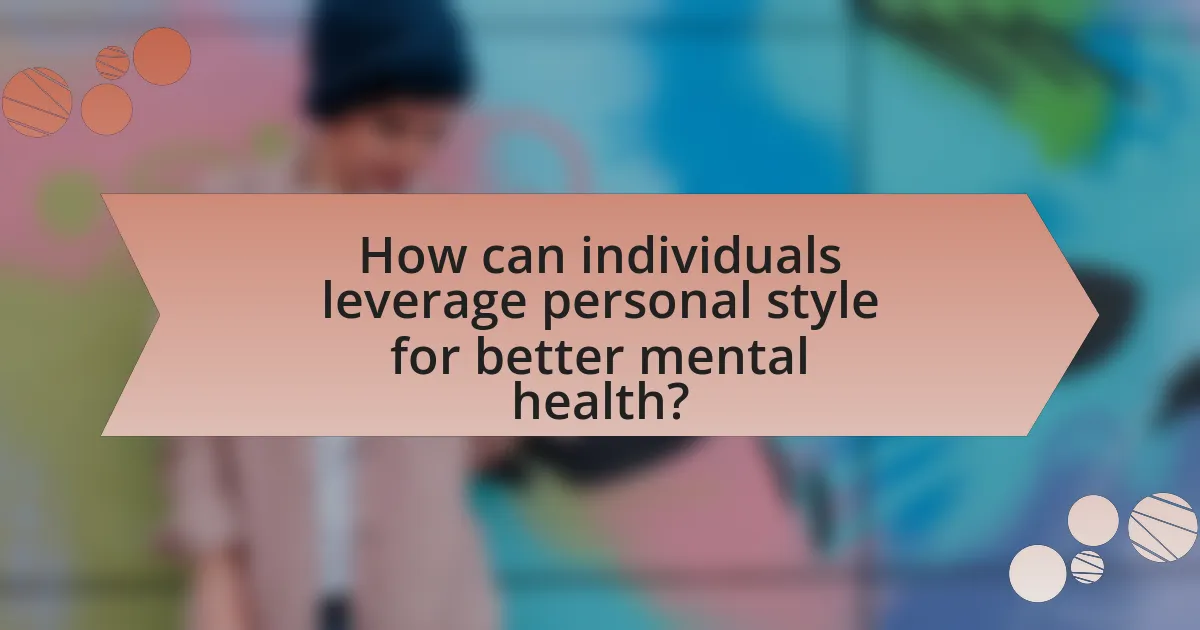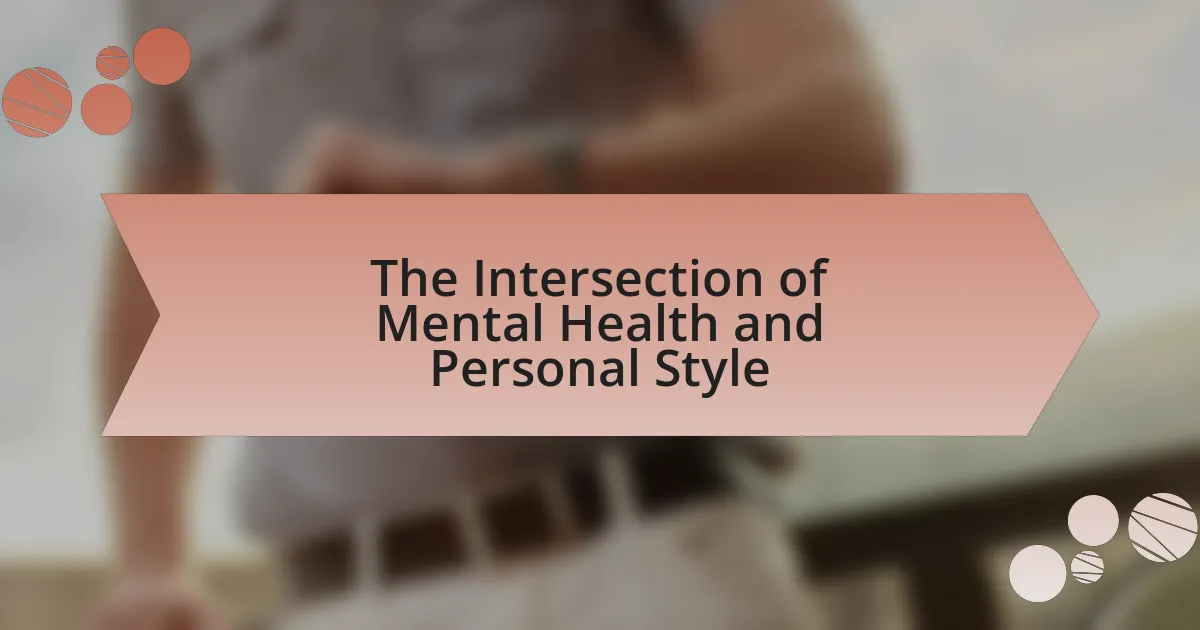The article explores the intersection of mental health and personal style, emphasizing how clothing choices and self-expression through fashion can significantly influence emotional well-being and self-perception. It discusses the reciprocal relationship between mental health and personal style, highlighting how mental states can affect clothing choices and vice versa. Key psychological factors such as self-identity, social influence, and emotional expression are examined, along with the impact of personal style on self-esteem and mental health. The article also addresses practical steps individuals can take to align their personal style with mental well-being, the role of community and social media, and strategies to overcome negative self-image related to style.

What is the Intersection of Mental Health and Personal Style?
The intersection of mental health and personal style lies in how individual expression through clothing and appearance can influence emotional well-being and self-perception. Research indicates that personal style can serve as a form of self-identity and empowerment, positively impacting mental health by enhancing self-esteem and promoting a sense of control. For instance, a study published in the Journal of Experimental Social Psychology found that individuals who dressed in a way that aligned with their personal identity reported higher levels of confidence and satisfaction. This connection illustrates that personal style is not merely superficial; it plays a significant role in shaping mental health outcomes.
How do mental health and personal style influence each other?
Mental health and personal style significantly influence each other, as an individual’s mental state can affect their clothing choices, while personal style can impact self-esteem and emotional well-being. For instance, research indicates that individuals experiencing depression may opt for more subdued clothing, reflecting their internal struggles, while those with positive mental health often express themselves through vibrant and confident attire. A study published in the Journal of Experimental Social Psychology found that wearing formal clothing can enhance abstract thinking and boost confidence, demonstrating how personal style can positively influence mental health. Conversely, adopting a personal style that aligns with one’s identity can foster a sense of belonging and improve overall mental well-being, creating a reciprocal relationship between the two.
What psychological factors contribute to personal style choices?
Psychological factors that contribute to personal style choices include self-identity, social influence, and emotional expression. Self-identity plays a crucial role as individuals often use clothing and accessories to communicate their personality and values, which is supported by research indicating that personal style can reflect one’s self-concept (Tiggemann, 2014). Social influence, including peer pressure and cultural norms, also significantly impacts style decisions, as individuals may adopt certain styles to fit in or stand out within their social groups (Kaiser, 2012). Additionally, emotional expression is a vital factor, as people often choose styles that resonate with their current mood or emotional state, which is evidenced by studies showing that clothing can affect and reflect emotions (Wang et al., 2016).
How can personal style impact mental well-being?
Personal style can significantly impact mental well-being by influencing self-esteem and self-expression. When individuals dress in a way that reflects their identity and preferences, they often experience increased confidence and a positive self-image. Research indicates that clothing choices can affect mood and behavior; for example, a study published in the Journal of Experimental Social Psychology found that participants wearing formal attire performed better on cognitive tasks, suggesting that clothing can enhance psychological states. Additionally, personal style allows for creative expression, which can serve as a therapeutic outlet, reducing stress and promoting emotional well-being.
Why is understanding this intersection important?
Understanding the intersection of mental health and personal style is important because it reveals how individual expression through clothing can significantly impact emotional well-being. Research indicates that personal style choices can enhance self-esteem and promote positive mental health outcomes, as individuals often use fashion as a means of self-identity and emotional expression. For instance, a study published in the Journal of Experimental Social Psychology found that wearing clothing that aligns with one’s self-image can lead to increased confidence and improved mood. This connection underscores the necessity of recognizing how personal style serves not only as a form of self-expression but also as a tool for mental health enhancement.
What role does self-expression play in mental health?
Self-expression plays a crucial role in mental health by allowing individuals to communicate their thoughts, emotions, and experiences, which can lead to improved emotional well-being. Engaging in self-expression through various forms such as art, writing, or fashion can serve as a therapeutic outlet, helping to reduce anxiety and depression. Research indicates that expressive activities can activate the brain’s reward system, promoting feelings of happiness and satisfaction. For instance, a study published in the Journal of Positive Psychology found that individuals who regularly engage in creative self-expression report higher levels of life satisfaction and lower levels of stress.
How can personal style serve as a coping mechanism?
Personal style can serve as a coping mechanism by allowing individuals to express their identity and emotions, which can enhance their mental well-being. When people curate their personal style, they often gain a sense of control and empowerment, helping to alleviate feelings of anxiety or depression. Research indicates that self-expression through clothing can lead to improved mood and self-esteem, as individuals feel more authentic and confident in their appearance. For instance, a study published in the Journal of Experimental Social Psychology found that wearing clothes that align with one’s self-image can positively influence mood and self-perception. This demonstrates that personal style not only reflects individual identity but also plays a significant role in emotional regulation and coping strategies.

What are the key components of personal style?
The key components of personal style include individual expression, clothing choices, color preferences, and accessories. Individual expression reflects a person’s personality and values, while clothing choices encompass the types of garments selected based on comfort, fit, and occasion. Color preferences influence how outfits are coordinated, impacting mood and perception. Accessories, such as jewelry, bags, and shoes, enhance overall appearance and can signify personal taste. These components collectively contribute to a unique personal style that can positively affect mental health by boosting confidence and self-esteem.
How do clothing choices reflect mental states?
Clothing choices reflect mental states by serving as a visual expression of an individual’s emotions and psychological well-being. For instance, research indicates that people experiencing depression may opt for darker, more muted colors, while those feeling confident and happy often choose brighter, more vibrant attire. A study published in the Journal of Experimental Social Psychology found that individuals wearing formal clothing reported higher levels of abstract thinking and confidence, suggesting a direct link between clothing and mental state. Additionally, clothing can act as a coping mechanism; for example, someone dealing with anxiety might wear comfortable, loose-fitting clothes to feel more at ease. Thus, the way individuals dress can provide insights into their mental health and emotional conditions.
What types of clothing are associated with different moods?
Different types of clothing are associated with various moods, influencing emotional states and self-perception. For instance, bright colors like yellow and orange are often linked to feelings of happiness and energy, while darker colors such as black and navy can evoke feelings of seriousness or sadness. Casual clothing, like sweatpants and t-shirts, is typically associated with comfort and relaxation, promoting a laid-back mood. In contrast, formal attire, such as suits and dresses, can instill confidence and a sense of professionalism. Research indicates that clothing choices can significantly impact mood and behavior, as demonstrated in a study published in the Journal of Experimental Social Psychology, which found that wearing formal clothing can enhance abstract thinking and increase feelings of power.
How does color psychology relate to personal style?
Color psychology significantly influences personal style by affecting emotions and perceptions associated with different colors. For instance, studies show that colors like blue can evoke feelings of calmness and trust, while red can stimulate excitement and passion. This understanding allows individuals to choose clothing that aligns with their desired emotional expression or the impression they wish to convey to others. Research published in the Journal of Experimental Psychology indicates that color can impact mood and behavior, reinforcing the idea that personal style choices are not merely aesthetic but also psychological.
What are the different styles and their psychological implications?
Different styles, such as casual, formal, bohemian, and minimalist, have distinct psychological implications that reflect individual personality traits and emotional states. Casual style often indicates a relaxed and approachable personality, suggesting comfort and ease in social interactions. Formal style may imply a desire for professionalism and structure, often associated with ambition and a need for control. Bohemian style reflects creativity and a free-spirited nature, often linked to openness and nonconformity. Minimalist style suggests a preference for simplicity and clarity, often associated with a desire for mental clarity and reduced stress. Research indicates that personal style choices can significantly influence self-perception and social interactions, reinforcing the connection between external appearance and internal psychological states.
How do casual styles affect self-perception?
Casual styles significantly influence self-perception by promoting comfort and authenticity, which can enhance an individual’s confidence. When individuals wear casual clothing, they often feel more relaxed and true to themselves, leading to a positive self-image. Research indicates that clothing choices can impact mood and self-esteem; for instance, a study published in the Journal of Experimental Social Psychology found that participants wearing casual attire reported higher levels of comfort and self-acceptance compared to those in formal wear. This suggests that casual styles can foster a more favorable self-perception by aligning external appearance with internal feelings of ease and identity.
What does a professional style convey about mental health?
A professional style conveys confidence and stability in mental health. Individuals who present themselves in a professional manner often exhibit traits associated with positive mental well-being, such as self-discipline and self-respect. Research indicates that dressing professionally can enhance self-esteem and influence how one is perceived by others, which can further reinforce a positive self-image. For instance, a study published in the Journal of Experimental Social Psychology found that participants who wore formal clothing performed better on cognitive tasks, suggesting that professional attire can enhance cognitive function and promote a sense of authority and competence. This connection between professional style and mental health underscores the importance of appearance in shaping self-perception and social interactions.

How can individuals leverage personal style for better mental health?
Individuals can leverage personal style for better mental health by using clothing and accessories as tools for self-expression and confidence enhancement. When individuals choose outfits that reflect their personality and make them feel good, it can lead to improved mood and self-esteem. Research indicates that wearing clothes that align with one’s identity can foster a sense of belonging and authenticity, which are crucial for mental well-being. For example, a study published in the Journal of Experimental Social Psychology found that individuals who dressed in a way that resonated with their self-image reported higher levels of confidence and satisfaction. Thus, personal style serves as a powerful means to positively influence mental health through self-affirmation and emotional expression.
What practical steps can be taken to align personal style with mental well-being?
To align personal style with mental well-being, individuals can adopt a few practical steps. First, they should identify clothing that makes them feel confident and comfortable, as studies show that wearing outfits that resonate with personal identity can enhance self-esteem and mood. For instance, research published in the Journal of Experimental Social Psychology indicates that clothing can influence psychological states, suggesting that dressing in a way that reflects one’s personality can lead to improved mental health outcomes. Additionally, individuals can curate a wardrobe that incorporates colors and styles that evoke positive emotions; for example, wearing bright colors has been linked to increased happiness. Lastly, engaging in mindful shopping—focusing on quality over quantity and selecting pieces that genuinely resonate with personal values—can foster a sense of fulfillment and reduce anxiety related to consumerism.
How can one identify their personal style to boost confidence?
To identify personal style and boost confidence, individuals should assess their preferences, experiment with different looks, and seek feedback from trusted sources. This process begins with self-reflection on what styles resonate personally, including colors, patterns, and silhouettes that evoke positive feelings. Experimentation involves trying on various outfits and combinations to discover what feels comfortable and authentic. Feedback from friends or family can provide valuable insights into how certain styles are perceived, helping refine choices. Research indicates that a strong personal style can enhance self-esteem and overall well-being, as individuals who express their identity through fashion often report higher levels of confidence and satisfaction.
What are some tips for using fashion as a form of self-care?
Using fashion as a form of self-care involves selecting clothing that enhances personal comfort and boosts self-esteem. Prioritizing comfort in fabric and fit can significantly improve mood, as studies indicate that wearing comfortable clothing can reduce stress levels. Additionally, curating a wardrobe that reflects personal style allows for self-expression, which is linked to improved mental well-being. Engaging in mindful shopping, where individuals choose pieces that resonate with their identity, can foster a sense of control and satisfaction. Furthermore, experimenting with colors and styles can elevate mood; research shows that colors can influence emotions, with brighter hues often associated with positivity.
What resources are available for exploring this intersection?
Resources available for exploring the intersection of mental health and personal style include academic journals, online platforms, and community workshops. Academic journals such as “Psychology of Fashion” provide peer-reviewed research on how personal style impacts mental well-being. Online platforms like Instagram and Pinterest offer visual inspiration and community support, showcasing how individuals express their mental health journeys through fashion. Additionally, workshops hosted by mental health organizations often incorporate style elements, allowing participants to explore self-expression through clothing. These resources collectively highlight the relationship between mental health and personal style, emphasizing the therapeutic benefits of fashion.
How can therapy and fashion intersect for personal growth?
Therapy and fashion can intersect for personal growth by using clothing as a tool for self-expression and identity exploration. Engaging in therapy often encourages individuals to reflect on their self-image and emotional well-being, which can lead to a desire to align their outward appearance with their inner self. Research indicates that personal style can significantly impact self-esteem and confidence; for instance, a study published in the Journal of Experimental Social Psychology found that wearing formal clothing can enhance abstract thinking and boost confidence. Therefore, by integrating fashion choices into therapeutic practices, individuals can actively participate in their personal growth journey, using style as a means to reinforce positive self-perception and emotional resilience.
What role do community and social media play in shaping personal style and mental health?
Community and social media significantly influence personal style and mental health by providing platforms for self-expression and connection. These platforms allow individuals to share their fashion choices and receive feedback, which can enhance self-esteem and foster a sense of belonging. Research indicates that social media can impact mental health positively by creating supportive communities; for instance, a study published in the Journal of Social and Clinical Psychology found that social media interactions can lead to increased feelings of social support and reduced feelings of loneliness. Conversely, exposure to idealized images can also contribute to negative self-perception and anxiety, highlighting the dual role of these platforms in shaping both style and mental health.
What are some common challenges faced in this intersection?
Common challenges faced at the intersection of mental health and personal style include societal pressure to conform to beauty standards, which can exacerbate feelings of inadequacy and anxiety. Individuals often struggle with self-expression due to fear of judgment, leading to a disconnect between their personal style and mental well-being. Additionally, mental health conditions such as depression can hinder motivation and energy levels, making it difficult for individuals to engage with their personal style. Research indicates that individuals with mental health issues may experience a lack of confidence in their appearance, further complicating their relationship with personal style.
How can societal pressures affect personal style choices?
Societal pressures significantly influence personal style choices by shaping individuals’ perceptions of what is considered acceptable or desirable. These pressures often stem from cultural norms, media representations, and peer influences, which can lead individuals to conform to specific fashion trends or styles to gain social acceptance. For instance, a study published in the Journal of Fashion Marketing and Management found that individuals often adjust their clothing choices based on the desire to fit in with their social groups, indicating that conformity to societal expectations plays a crucial role in personal style decisions.
What strategies can help overcome negative self-image related to style?
To overcome negative self-image related to style, individuals can adopt several effective strategies. First, practicing self-compassion allows individuals to treat themselves with kindness and understanding, which can reduce negative self-talk and improve overall self-esteem. Research indicates that self-compassion is linked to greater emotional resilience and a more positive self-image.
Second, engaging in positive affirmations can help reframe negative thoughts about personal style. By regularly stating affirmations that focus on strengths and unique qualities, individuals can shift their mindset towards a more positive self-perception. Studies show that positive affirmations can enhance self-worth and reduce anxiety.
Third, seeking professional guidance from a stylist or therapist can provide personalized advice and support, helping individuals to identify styles that resonate with their identity and boost confidence. Evidence suggests that professional styling can lead to improved self-image and satisfaction with personal appearance.
Lastly, experimenting with different styles and clothing can foster a sense of exploration and self-discovery, allowing individuals to find what truly reflects their personality. This approach can lead to increased comfort and confidence in one’s appearance, as supported by findings that suggest trying new styles can enhance self-expression and satisfaction.
How can one create a personal style that supports mental health?
One can create a personal style that supports mental health by prioritizing comfort and self-expression in clothing choices. Choosing outfits that feel good physically can reduce anxiety and promote a positive self-image. Research indicates that wearing clothes that align with one’s identity can enhance mood and self-esteem, as noted in a study published in the Journal of Experimental Social Psychology, which found that individuals who dress in a way that reflects their personality report higher levels of happiness. Additionally, incorporating colors and styles that evoke positive emotions can further enhance mental well-being, as color psychology suggests that certain hues can influence mood.
